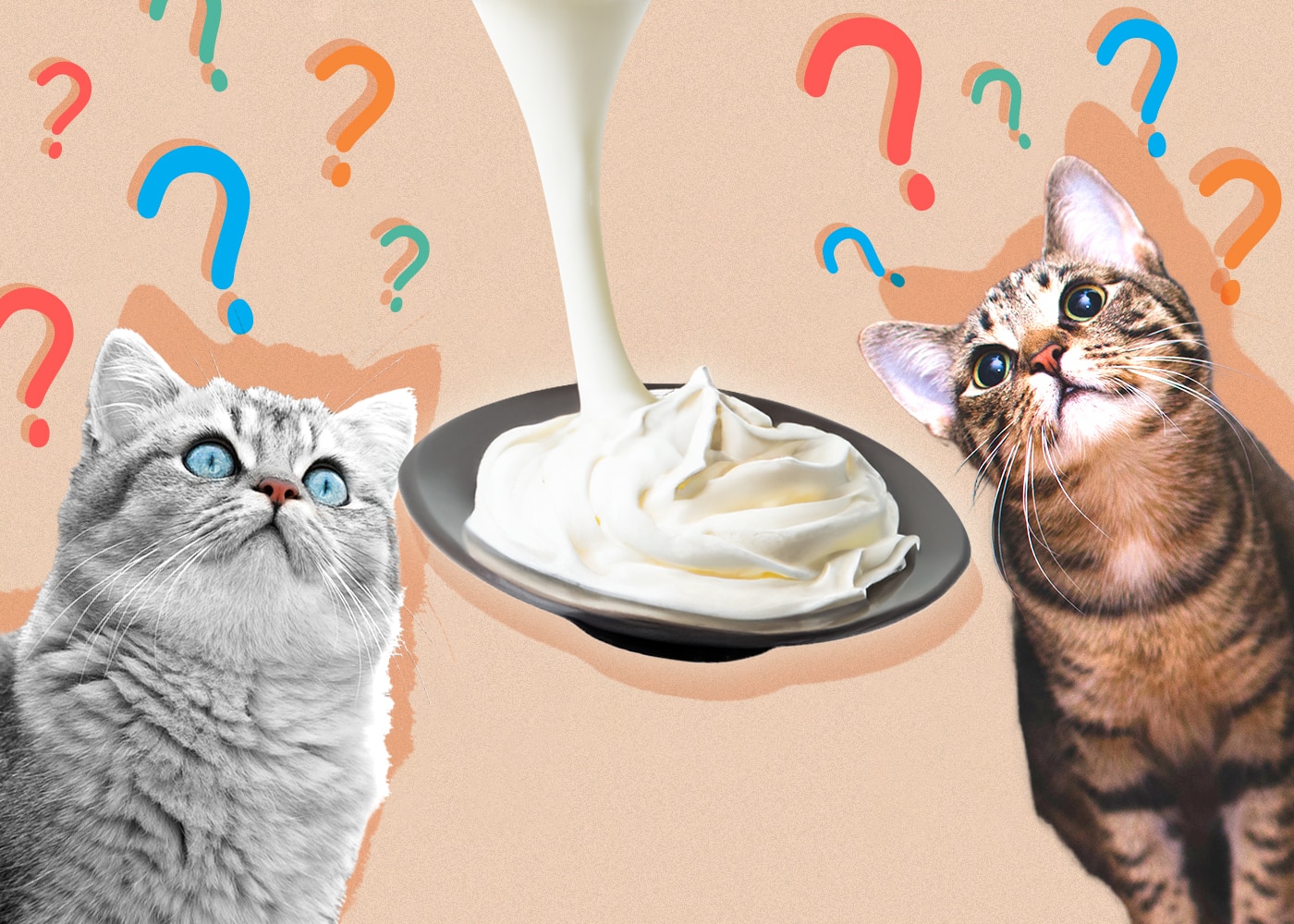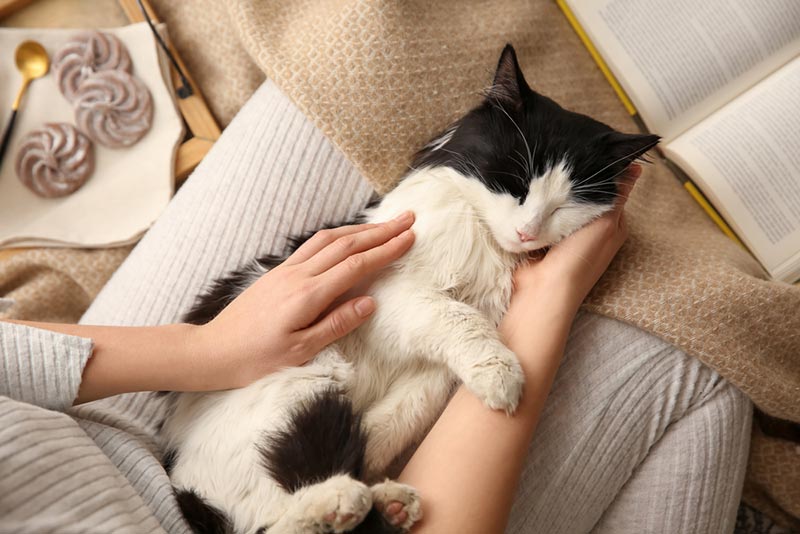Persian Cat: Pictures, Care Guide, Temperament & Traits
Updated on
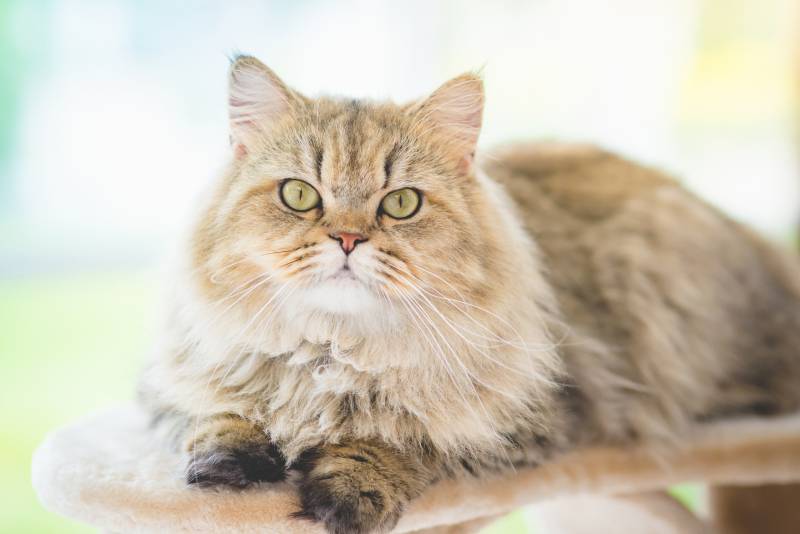
Click Below to Skip Ahead
Breed Overview
| Height: | 10–15 inches |
| Weight: | 7–12 pounds |
| Lifespan: | 10–13 years |
| Colors: | White, black, blue, red, cream, lilac, and chocolate |
| Suitable for: | Apartment life, individuals or families who value quiet time |
| Temperament: | Gentle, friendly, lazy, docile |
There are several Persian varieties to know about. The Doll Face Persian, also known as the Traditional or Old-Fashioned variant, is believed to be the original. They don’t have extreme facial features like the Peke-Faced Persians with their flat, “pushed-in” faces and associated health problems.
Regardless of which type we’re talking about, these beautiful cats are consistently part of the Cat Fanciers’ Association of 10 most beloved breeds for a reason. Their gentle and sweet nature, paired with an attractive appearance, makes them highly sought after.
If you’re considering adopting one, there are some things you need to know first. Read on to learn everything you need to know about the breed, including their care requirements and health concerns.
Persian Cat Characteristics
Persian Cat Breed Kittens
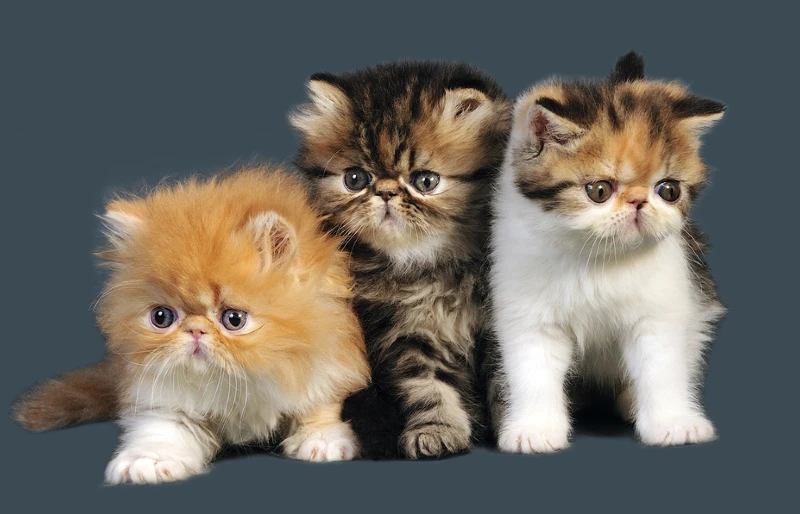
As mentioned above, Persians are one of the most popular cat breeds in the world, so finding a breeder nearby should be relatively easy. However, don’t let that fool you into thinking you’ll be able to adopt this breed on a tight budget.
Persians are notoriously expensive cats to acquire, and those with a show or championship bloodline will be even more expensive. If you have your heart set on a specific coloration or pattern, you should also expect to pay more, as some are rarer and in much higher demand.
If you’re serious about adopting a Persian, don’t select a kitten from the cheapest breeder you find. Irresponsible breeders may sell their kittens at a much more affordable price, but you’ll likely pay for that in the long run with high vet bills due to poor breeding practices.
Temperament & Intelligence of the Persian Cat
Persian cats are known for their gentle, laidback, and quiet temperament. They prefer tranquil environments and would take a snuggle on the couch over scaling your kitchen cupboards any day. These sweet cats can exhibit short bursts of kitten-like activity, but you shouldn’t expect them to get into too much trouble jumping or climbing onto things. Persians are happiest when they’re stretched out next to you or sitting on your lap. Once they’ve found a cozy spot, they can spend their entire day lazing there, making them one of the laziest cat breeds in the world. A Persian would literally spend their whole day sleeping if they didn’t have to get up to drink, eat, and use their litter box.
Are These Cats Good for Families? 👪
Persians can make fantastic family pets as they’re known for their sweet, patient, and gentle temperaments. They really love people and can get along fine with children who know how to respect boundaries. The breed generally prefers a quiet and calm environment, but they can learn to adapt to more active and noisy households.
Does This Breed Get Along With Other Pets?
The Persian’s sweet and gentle personality makes them a great pick for households that have other cats. They can even get along with quiet dogs that can respect their boundaries. You can increase the chances of your pets getting along by ensuring you introduce the two slowly and deliberately.
Things to Know When Owning a Persian Cat:
Food & Diet Requirements 🐡
Persians are a very laidback and lazy breed, so they need to be fed appropriately to ensure they don’t overeat and wind up obese due to their lowered activity levels. This is one breed you do not want to free feed, so aim for two or three portion-controlled meals daily. Their diet should consist of nutritious, protein-rich commercial cat food that meets the requirements for their current life stage.
Please pay close attention to your Persian as they eat. Some may encounter problems with a misaligned jaw due to their flat faces. This can cause problems when they try to pick up or chew their food. If you notice this is an issue for your cat, we recommend asking your veterinarian about foods designed specifically with Persians in mind. This kibble is made of shapes known to be easier for this breed to eat.
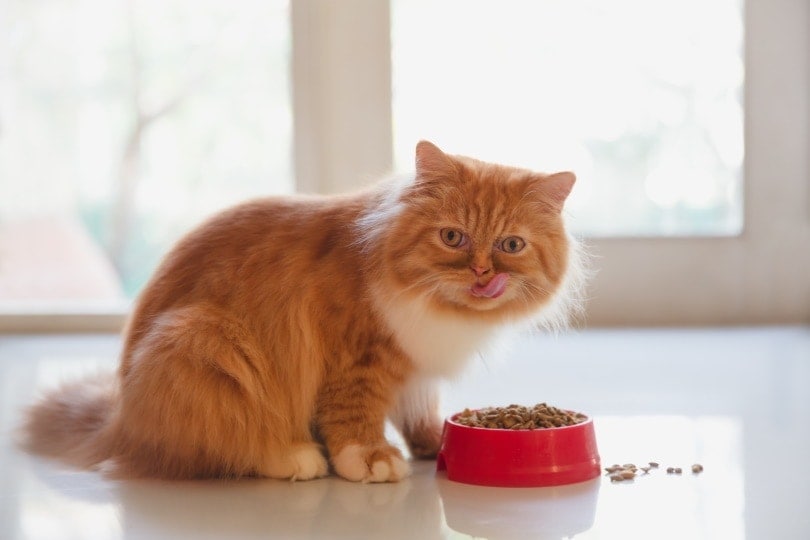
Exercise 🐈
As we’ve already mentioned, Persians are generally a low-energy breed. They’re happy to spend their entire day lounging. That doesn’t mean you should necessarily encourage this, however. Play with your Persian in short bursts throughout the day. They’re not particularly fond of jumping or climbing, so we recommend finding a chasing type of activity to try to cater to your pet’s inner hunter. Try laser pointers, balls, or catnip-filled toys to see which your kitty likes best.
Training 🧶
Persians are intelligent cats that can be trained to respond to your cues. If you plan on training your Persian, we recommend investing in a clicker and plenty of positive reinforcement (e.g., high-reward treats) to encourage your pet to learn faster.
Grooming ✂️
Persians are known for their beautiful, thick, and long coats. Unfortunately, their coats are high maintenance and will require much from you to keep them looking their best. Their fur can be oily and may be prone to matting, so you’ll need to brush it daily. Buy a comb that can reach your pet’s thick undercoat to ensure you’re tackling any tangles before they can turn into painful mats. Skipping out on grooming sessions can result in large knots that will require the hand of an expert groomer and may mean your kitty will need to get shaved.
It’s not just your Persian’s coat that you’ll need to pay close attention to. This flat-faced breed produces more tears than others, which can cause tear staining. We recommend cleaning your cat’s eyes daily with a warm and damp cotton face cloth to remove visible stains.
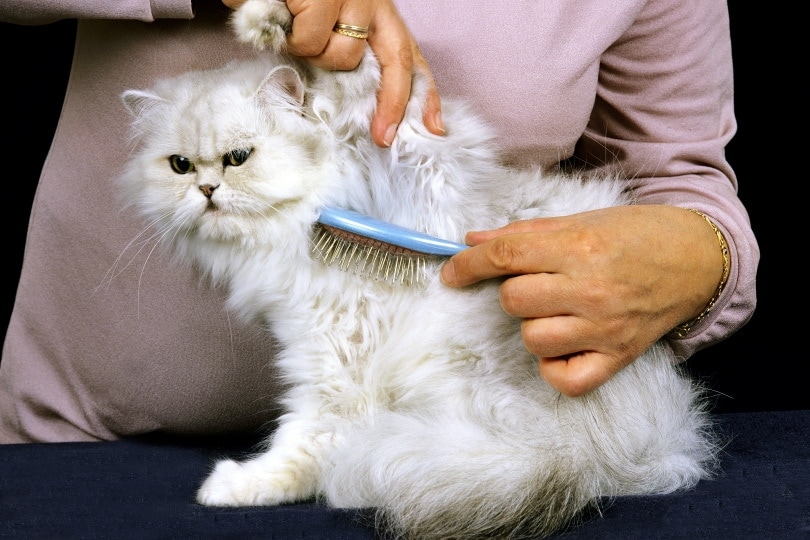
Health and Conditions 🏥
While some sources suggest that Persians can live the standard 15-to-20-year lifespan of most other cat breeds, this doesn’t appear to be the case. Studies show they live to be just 13.5 years old and that 64.9% of all Persians will suffer from at least one health condition.
The most common conditions noted in the breed include haircoat problems, dental disease, overgrown nails, and eye discharge. The high incidence of issues with dental and eye health is thought to be because of the breed’s flatter face.
If you adopt a Peke-Faced Persian, know that their facial configuration will likely cause it to suffer from medical issues that can worsen as your kitty enters their golden years. Their facial anatomy may also put them at risk of upper airway conditions known as brachycephalic airway syndrome.
The most common causes of death in Persians were kidney disease and cancer. Polycystic kidney disease (PKD) causes kidney failure and has an incidence rate of 36–49% in Persians.
- Coat disorders
- Skin disorders
- Eye conditions
- Dental disease
- PKD
- Cancer
Male vs Female
The only confirmed difference between female and male Persians is their size. Males are larger in both height and weight than their female counterparts. There are some anecdotal reports of males and females having different personality traits, but these are not based on science and are instead noted by current Persian owners. Sex is not a determining factor in temperament, as it appears that how the animal is raised plays more of a role in how the personality develops.
3 Little-Known Facts About the Persian Cat
1. Persians come in many colors and coat patterns.
There are seven divisions of Persian cat colors, including solid, silver and golden, smoke and shaded, tabby, bicolor, and particolor. As mentioned above, the seven solid colors include white, black, blue, cream, chocolate, lilac, and red. However, within the other six divisions is a huge variety of colorations and patterns, including chinchilla, mackerel tabby, calico, silver tabby, tortoiseshell, and lilac-cream, just to name a few.
2. The Persian is the jumping-off point for many other breeds.
Persians played a huge part in the creation of many other well-loved breeds. The Exotic Shorthair, for example, was bred to be the shorthaired variant of the Persian. They did adopt the brachycephalic facial structure, however, which makes them prone to a variety of health conditions.
The Burmilla is a domestic cat breed resulting from crossing a Chinchilla Persian with a Burmese.
The Himalayan is a sub-breed resulting from crossing a Siamese with a Persian.
3. Persians didn’t always have their trademark flat face.
In the 1950s, a spontaneous mutation caused the flat face that many of us know as a trademark for the breed. Until that point, Persians didn’t have flat faces. These “peke-faced” cats, named as such after the flat-faced Pekingese dog breed, became a separate breed entirely from the Persian. However, by the mid-1990s, popularity dropped significantly due to the well-known health issues that often plagued the breed.
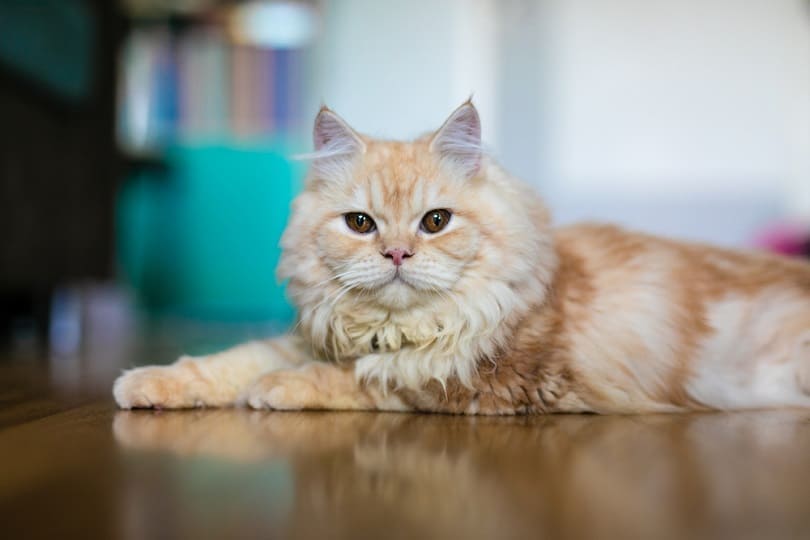
Final Thoughts
Persians are a truly beautiful breed with many redeeming characteristics. If their docile and sweet personalities don’t wrangle you in, their gorgeous and plush coats, huge expressive eyes, and smushed faces might.
Families looking to adopt a Persian should be prepared to perform at-home grooming sessions daily to keep their pets looking their best. A poorly groomed Persian may develop painful mats that require shaving to remove.
If you plan on welcoming a Persian into your home, please do your research to ensure you adopt from a reputable breeder who uses safe breeding practices. Backyard breeders are plentiful and, unfortunately, do not have the cat’s best interest at heart. While these kittens may be cheaper to acquire, you may be burned in the long run with expensive veterinary bills due to poor health from bad breeding.
Featured Image Credit: ANURAK PONGPATIMET, Shutterstock


